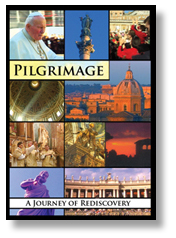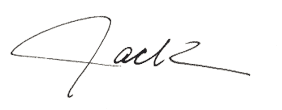Me and My RC
The rational re-organization of American religion
Pilgrimage, A Journey of Rediscovery:
See the renaissance of traditional Catholicism on DVD.
Hear (then) Cardinal Ratzinger speak -- before he became Pope Benedict XVI.
© Jack Cashill
Originally published in the Wall Street Journal - 1985
Jack Cashill: Wall Street Journal, 1985
Although the Roman Catholic Church has continued to maintain a 24 percent share of the U.S. market, it has nonetheless witnessed a decline in annual, per capita, “real dollar” donations. And the problem, one must confess, lies in the Church’s painfully random and unscientific product innovation.
This is all the more unfortunate since for 2,000 years the Catholic Church was “it,” “the” church, the “real thing.” It had survived—nearly unchanged—persecution, heresies, and even the Protestant Reformulation (though this last cost a good chunk of market share). Over the years, too, the church had developed an enviable level of brand identification.
Then along comes Vatican II and the ecumenical movement, and all the rules are changed without even test marketing the new ones. The result of this abrupt change, as one might imagine, has been a considerable increase in confusion and a corresponding decrease in brand loyalty, donations, and bingo receipts.
To survive, the church will need a promotional blitz the intensity of which has not been seen since the Pepsi Challenge. At the heart of this crusade there must be a rational strategy of market segmentation. And in this regard I have recommended a clear positioning of the church and a sensitive cannibalization of the brand name.
The church’s first task is to demarcate its contemporary thrust, the one that features hip priests, handshaking, hugging, and other manifestations of universal niceness. The likely public here is those upscale consumers who stay up late to watch M.A.S.H. reruns and still have John Anderson bumper stickers on their Volvo station wagons. Nothing heavy here.
As a brand name for this segment I originally decided on “Diet Rites.” With this label, I had hoped both to capture the frothy modern effervescence of this sect and to suggest a tie to the Diet of Worms, an 1122 A.D. pow-wow that liberalized Christianity. Alas, during a comprehensive mall intercept, “Diet Rites” tested too obscure and arcane. The name that truly caught consumer fancy was “RC Light,” a bit trendy perhaps, but nevertheless a catchy and telling way of summing up contemporary Roman Catholicism.
More difficult is the positioning of the conservative tradition of Roman Catholicism that thrived up until the mid-1960’s and that survives, though a bit underground, even today. Given my own biases, I would like to have promoted it as Roman Catholicism, but I feared that this would de-legitimatize RC Light. And for reasons obvious even to a novice marketer, I would not call it RC Dark or RC Heavy. So I prayed for inspiration and descending upon me, as though a tongue of fire, came the name RC Classic, the perfect choice for reviving a formula that has been imprudently discarded.
Ever aggressive, I have decided to probe further into potential territory by establishing a three-sect strategy. My idea here is to pioneer the radical segment and to shape a sect around the needs of those young people more interested now in liberation theology than in Papal Bulls, but whose potential earning power cannot be ignored. My choice of brand name: RC Free.
As I see it, each sect will still report to Rome and will still subscribe to transubstantiation, the virgin birth, and maybe even original sin—depending on how they test. Nevertheless, the attractive diversity of these new product lines should transform Catholicism from a warehouse of equity to a viable, ongoing contender.
I have little doubt as well that Catholicism’s new aggressiveness will impact middle-of-road Protestantism. The fact is that many of the Protestant churches (PCs) have maintained a stand-back style since the Reformulation and have been watching their market shares ebb for more than 400 years. So I am sure there will be a shakeout. Indeed, after the big RC push, we can expect to see some of the more marginal, undifferentiated PCs go belly up.
To right the situation, the individual churches will have to understand that there is just so much theological shelf space, that product differentiation is not viable for go-as-you-please Protestantism. Currently, none of the mainstream Protestant churches—your Lutherans, your Episcopalians, your Baptists, your Methodists—can really claim more than a 10 percent market share. Yet their prospects are better than their shares might indicate. After all, these are some well known and respected brands with good national distribution networks already in place.
My strategy is to consolidate the various brand names, even the strong flagship brands like “Southern Baptist,” into one readily identifiable Exxon-like entry. The target here is Mom, Dad, Butch, and Sis—solid suburban Americans who want a little God in their life and a place to go before brunch.
After a conjoint analysis of various stimulus combinations, I have decided upon the brand, Middle American Christian Church, or MacChurch for ad purposes. I will not be certain of MacChurch’s theology until the focus groups are run, but I plan on following the promotional path blazed so successfully by Holiday Inn. In other words, this will be your basic “no-surpises” church. When Dad brings the family here, he can be sure that they will not be asked to speak in tongues, handle snakes, or give money to the Sandinistas.
As for Judaism, my plans are more modest. After all, with its orthodox, conservative, and reformed brands, Judaism all but created the science of rational segmentation. Still and all, this faith could use one more brand to plug the hole in its product lines and to recaptures—yes, you guessed it—the all but lost tribes of the Pepsi Generation.
Author’s note: This satire of contemporary, market-oriented religion was published in the Wall Street Journal in 1985 and reprinted with permission at least 100 times, usually by church organizations that failed to understand the bite behind the satire.
Providentially, three years later, Pope John Paul II issued the revolutionary Motu Proprio, Ecclesia Dei, an Apostolic letter that reauthorized the Latin Mass worldwide. Ten years later, I was commissioned to produce a documentary called “Pilgrimage: A Journey of Rediscovery” that captured the celebration in Rome of the tenth anniversary of that same Apostolic letter.
In the course of shooting the video, I attended an audience with Pope John Paul II and interviewed one-on-one then Cardinal, Josef Ratzinger, now Pope Benedict XVI. After twenty-five years wandering in my own personal desert, I have been a regular participant at a traditional mass ever since.
Cashill Newsletter


